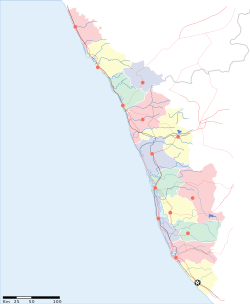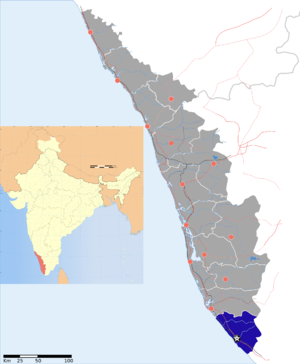Thiruvananthapuram
| Thiruvananthapuram (തിരുവനന്തപുരം) Trivandrum |
|
| Evergreen city of India | |
| — capital — | |
 |
|
|
|
|
| Coordinates | |
| Country | |
| State | Kerala |
| District(s) | Thiruvananthapuram |
| Mayor | C. Jayan Babu |
| Deputy Mayor | Jayaprakash |
| Planning Agency | TRIDA |
| Civic agency | Thiruvananthapuram Corporation |
| Population • Density |
744,739[1] (2001[update]) • 5,284 /km2 (13,685 /sq mi) |
| Sex ratio | 1018 ♂/♀ |
| Literacy • Male |
88.26% • 94.82% |
| Official languages | Malayalam · English |
|---|---|
| Spoken languages | Malayalam · Tamil |
| Time zone | IST (UTC+5:30) |
| Area |
141.74 km2 (55 sq mi) • 250.00 square kilometres (96.53 sq mi) |
| Climate • Precipitation |
Am/Aw (Köppen) • 1,700 mm (67 in) |
| Website | www.corporationoftrivandrum.in |
Thiruvananthapuram ([t̪iruʋənɨn̪t̪əpurəm]; Malayalam: തിരുവനന്തപുരം, tiruvaṉantapuraṁ ?), also known as Trivandrum (Anglicised name), is the capital of the Indian state of Kerala and the headquarters of the Thiruvananthapuram District. It is located on the west coast of India near the extreme south of the mainland. Referred to by Mahatma Gandhi as the "Evergreen city of India", the city is characterized by its undulating terrain of low coastal hills and busy commercial alleys.[3] With almost 745,000 inhabitants per the 2001 census, it is the largest and most populous city in Kerala; the wider urban agglomeration has a population of more than one million.[4][5] Apart from being the IT hub of the state with over 80% of the state's software exports, Thiruvananthapuram ranks first in the number of international tourists in Kerala also.[6][7]
The city is the state capital and houses many central and state government offices, organizations and companies. Apart from being the political nerve centre of Kerala, it is also a major academic hub and is home to several educational institutions including the University of Kerala, and to many science and technology institutions, the most prominent being the Vikram Sarabhai Space Centre (VSSC), Technopark, the Indian Institute of Space Science and Technology (IIST) and the Indian Institute of Science, Education and Research (IISER). It is also considered as one of the cleanest cities in India.[8]
Contents |
Origin of name
Thiruvananthapuram means "Abode of Lord Ananta" in Malayalam.[9] The name derives from the deity of the Hindu temple at the centre of the city. Anantha is the serpent Shesha on whom Padmanabhan or Vishnu reclines. The temple of Vishnu reclining on Anantha, the Sri Padmanabhaswamy temple remains the iconic landmark of the city. The city was officially referred to as Trivandrum in English until 1991, when the government decided to reinstate the city's original name Thiruvananthapuram in all languages.
History

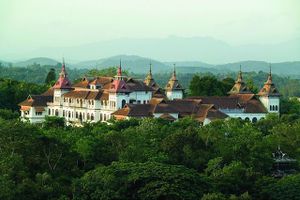
Thiruvananthapuram is an ancient city with trading traditions dating back to 1000 BCE.[11][12] It is believed that the ships of King Solomon landed in a port called Ophir (now Poovar) in Thiruvananthapuram in 1036 BCE.[13] The city was the trading post of spices, sandalwood and ivory.[14] However, the ancient political and cultural history of the city was almost entirely independent from that of the rest of Kerala. The early rulers of the city were the Ays. With their fall in the 10th century, the city was taken over by the rulers of Venad.[15]
The rise of modern Thiruvananthapuram began with accession of Marthanda Varma in 1729 as the founding ruler of the princely state of Travancore (Thiruvithamkoor in the local vernacular). Thiruvananthapuram was made the capital of Travancore in 1745 after shifting the capital from Padmanabhapuram in Kanyakumari district.[16] The city developed into a major intellectual and artistic centre during this period. The golden age in the city's history was during the mid 19th century under the reign of Maharaja Swathi Thirunal and Maharaja Ayilyam Thirunal. This era saw the establishment of the first English school (1834), the Observatory (1837), the General Hospital (1839), the Oriental Research Institute & Manuscripts Library and the University College (1873). The first mental hospital in the state was also started during the same period. Sanskrit College, Ayurveda College, Law College and a second grade college for women were started by Moolam Thirunal (1885–1924).[15]
The early 20th century was an age of tremendous political and social changes in the city. The Sree Moolam Assembly, established in 1904 was the first democratically elected legislative council in any Indian state. Despite not being under direct control of the British Empire at any time, the city however featured prominently in India's freedom struggle. The Indian National Congress had a very active presence in the city. A meeting of the Indian National Congress presided by Dr. Pattabhi Sitaramaiah was held here in 1938.
The period of Chitra Thirunal Bala Rama Varma, who took over in 1931, witnessed many-sided progress. The promulgation of "Temple Entry Proclamation" (1936) was an act that underlined social emancipation. This era also saw the establishment of the University of Travancore in 1937, which later became the Kerala University.
With the end of the British rule in 1947, Travancore chose to join the Indian union. The first popular ministry headed by Pattom Thanu Pillai was installed in office on 24 March 1948. In 1949, Thiruvananthapuram became the capital of Thiru-Kochi, the state formed by the integration of Travancore with its northern neighbour Kochi. The king of Travancore, Chitra Thirunal Bala Rama Varma became the Rajpramukh of the Travancore-Cochin Union from July 1, 1949 until October 31, 1956. When the state of Kerala was formed on November 1, 1956, Thiruvananthapuram became the capital of the new state.
With the establishment of Thumba Equatorial Rocket Launching Station (TERLS) in 1962, Thiruvananthapuram became the cradle of India's ambitious space programme. The first Indian space rocket was developed and launched from the Vikram Sarabhai Space Centre (VSSC) located in the outskirts of the city in 1963. Several establishments of the Indian Space Research Organization (ISRO) were later established in Thiruvananthapuram.[17]
A major milestone in the city's recent history was the establishment of Technopark—India's first IT park—in 1995.[18] Technopark has developed into the largest IT Park in India and third largest in Asia and is home to MNC giants like Infosys, TCS, Ernst & Young, IBS Software Services, UST Global, HCL Infosystems etc.; employing around 30,000 people in close to 185 companies.[19] This placed Thiruvananthapuram on the IT map of India and it is today one of the most promising in the country in terms of competitiveness and capability.[20]
Geography and climate

Thiruvananthapuram is built on hills by the sea shore and is located at on the west coast, near the southern tip of mainland India.[21] The city situated on the west coast of India, and is bounded by Arabian Sea to its west and the Western Ghats to its east. The city and the suburbs spans an area of 250 km2 (96.53 sq mi). The average elevation of the city is 16 ft above sea level.[22] The Geological Survey of India has identified Thiruvananthapuram as a moderately earthquake-prone urban centre and categorized the city in the Seismic III Zone.[23]
Thiruvananthapuram lies on the shores of Karamana and Killi river s. Thiruvallam and Veli backwaters lies in the city.[24]
The area can be divided into two geographical regions, the midlands and the lowlands. The midland region comprises low hills and valleys adjoining the Western Ghats. The lowland is a narrow stretch comprising shorelines, rivers and deltas, dotted with coconut palms.Vellayani Lake, the largest freshwater lake in the district, is in the suburbs of the city.
There are highlands, which form the eastern suburbs of the city. The highest point in the district is the Agasthyarkoodam which rises 1869 m above sea level. Ponmudi and Mukkunimala are hill-resorts near the city.
Climate
The city has a climate that borders between a tropical savanna climate and a tropical monsoon climate. As a result it does not experience distinct seasons. The mean maximum temperature 34 °C and the mean minimum temperature is 21 °C. The humidity is high and rises to about 90% during the monsoon season.[25] Thiruvananthapuram is the first city along the path of the south-west monsoons and gets its first showers in early June. The city gets heavy rainfall of around 1700 mm per year. The city also gets rain from the receding north-east monsoons which hit the city by October. The dry season sets in by December. December, January and February are the coldest months while March, April and May are the hottest. The winter temperature comes down to about 15 °C. Highest temperatures recorded is 37 °C.[26]
| Climate data for Thiruvananthapuram | |||||||||||||
|---|---|---|---|---|---|---|---|---|---|---|---|---|---|
| Month | Jan | Feb | Mar | Apr | May | Jun | Jul | Aug | Sep | Oct | Nov | Dec | Year |
| Record high °C (°F) | 37 (99) |
38 (100) |
38 (100) |
38 (100) |
38 (100) |
39 (102) |
38 (100) |
38 (100) |
33 (91) |
38 (100) |
37 (99) |
36 (97) |
39 (102) |
| Average high °C (°F) | 31.5 (88.7) |
31.9 (89.4) |
32.6 (90.7) |
32.6 (90.7) |
31.6 (88.9) |
29.7 (85.5) |
29.2 (84.6) |
29.4 (84.9) |
30.0 (86) |
29.9 (85.8) |
30.3 (86.5) |
31.0 (87.8) |
30.8 (87.4) |
| Average low °C (°F) | 22.2 (72) |
22.8 (73) |
24.1 (75.4) |
24.9 (76.8) |
24.7 (76.5) |
23.5 (74.3) |
23.1 (73.6) |
23.2 (73.8) |
23.3 (73.9) |
23.3 (73.9) |
23.1 (73.6) |
22.6 (72.7) |
23.4 (74.1) |
| Record low °C (°F) | 15 (59) |
17 (63) |
20 (68) |
20 (68) |
20 (68) |
21 (70) |
18 (64) |
20 (68) |
18 (64) |
20 (68) |
20 (68) |
20 (68) |
15 (59) |
| Precipitation mm (inches) | 22.7 (0.894) |
24.4 (0.961) |
40.4 (1.591) |
117.4 (4.622) |
230.4 (9.071) |
320.8 (12.63) |
226.8 (8.929) |
138.1 (5.437) |
174.6 (6.874) |
281.7 (11.091) |
184.5 (7.264) |
65.9 (2.594) |
1,827.7 (71.957) |
| Source #1: [27] | |||||||||||||
| Source #2: [28] | |||||||||||||
Economy
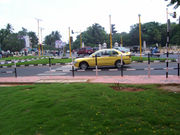
The economy of Thiruvananthapuram city was earlier based on the tertiary sector with about 60% of the workforce being employed as government servants. Large scale industrial establishments are low compared to other south Indian state capitals like Bangalore and Chennai. At present the economy is growing with the contributions from more professionals in the fields of IT, and Medical/Bio-Technology. The city contributes 80% of software exports from the state.[29] The opening of many private Television channels in the state made Thiruvananthapuram the home of several studios and related industries. India's first animation park Kinfra Film and Video Park is situated here.[30][31]
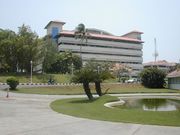
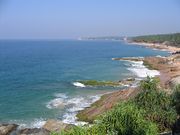
Since the establishment of Technopark in 1995, Thiruvananthapuram has steadily grown into a competitive IT centre. The city was rated as the best 2nd tier metro with IT/ITES infrastructure, and second in terms of availability of human talent.[20][32] Technopark houses global majors like IBS Software Services, NeST Software, Infosys, TCS, McKinsey & Co., Ernst & Young, Allianz Cornhill, Tata Elxsi, HCL Infosystems, UST Global, SunTec Business Solutions etc. The park has around 185 companies employing over 30,000 professionals.[33] This is the first CMMI Level 4 assessed Technology Park which spreads over 330 acres, and about 4 million sq.ft. of built-up space[34] As Phase IV expansion, Technopark is developing 450 acres of land in Pallippuram, 5 km north from the main campus as Technocity.[35]
Tourism has also contributed heavily to the economy of Thiruvananthapuram. Foreign tourists generally use Thiruvananthapuram as a hub to explore the highly promoted tourism industry of the state of Kerala.[36][37] Thiruvananthapuram is ranked first in the number of foreign tourists visiting Kerala.[38] It is also a major destination for chartered flights to India for medical tourism, as there are more than fifty recognised Ayurveda centres in and around the city. This is primarily due to Ayurveda's immense popularity in the West. Medical tourism is further promoted by the recuperation facilities available at the beach resorts and hill stations nearby. There are around 20 government owned and 60 privately owned medium and large scale industrial units in Thiruvanathapuram. The major employers are the KSIDC, Milma, Keltron, Travancore Titanium and Hindustan Latex, all government owned. There are also about 30,000 small scale industrial units employing around 115,000 people. Traditional industries include handloom and coir.[39]
Commercial activity is quite low mainly due to the under-development of ports. However, this is expected to change with the construction of the proposed mega Deep Water Container Transshipment Port at Vizhinjam.[40] Situated close to the city, Vizhinjam is very close to international shipping routes and the East-West shipping axis and hardly require maintenance dredging.[41] Other major organizations of economic interest are the Chithranjali Film Complex, Kinfra Apparel Park, Kinfra Film and Video Park, Kerala Hitech Industries (KELTECH), Kerala Automobiles Limited and the English Indian Clays Ltd.
Government and politics

The District Administration is headed by the District Collector, an officer of the elite Indian Administrative Service.
The city is administered by the Thiruvananthapuram Corporation headed by the Mayor. The city council is democratically elected and comprises 84 members representing the different city wards. Several agencies work under or in partnership with the Corporation including the Thiruvananthapuram Development Authority (TRIDA) and Trivandrum Road Development Corporation.
The city comes under the Thiruvananthapuram Lok Sabha constituency. The city contributes to four legislative assembly seats namely Kazhakuttam, Thiruvananthapuram, Nemom and Kovalam.[42]
The city police is headed by a Police Commissioner, an officer of Deputy Inspector General rank in the Indian Police Service. The city is divided into three police sub-divisions headed by Assistant Commissioners. There are also two traffic sub-divisions. A women's cell and a narcotics control cell also operate in the city. The other units of Thiruvananthapuram city police include Crime Detachment, City Special Branch, Dog Squad, Mounted Police, District Crime Records Bureau, Foreigners Registration Office (FRO), Tourist Police and District Armed Reserve.[43] There are two state Armed Police Battalions and a unit of the Central Reserve Police Force (CRPF) based in Thiruvananthapuram. The CRPF has a Group Head Quarters (GHQ) located at Pallipuram. There is also a large army cantonment in Pangode where some regiments of the Indian Army are based.
Thiruvananthapuram is the capital of Kerala and hence the state legislative assembly and Secretariat are located here. The city is also the headquarters of the Thiruvananthapuram district. The foreign missions in the city are the Consulate of Maldives[44] and Honarary Consulate of Russia.
Infrastructure
The city is fully electrified by Kerala State Electricity Board (KSEB). The district is divided into three circles: Transmission circle, Thiruvananthapuram city and Kattakkada. Domestic consumers account for 43% of the total power consumption, or 90 million units per month. Thiruvananthapuram district has one 220 kV, nine 110 kV and six 66 kV electrical substations. A 400 kV substation has just been commissioned by the Power Grid Corporation and will ensure high-quality power supply to the city.[45]
The water supply schemes cover 100% within the city limits. It is 84% of the urban and 69% of the rural population, when the district is considered. Peppara and Aruvikkara dams are the main sources of water for distribution in the capital city. The new project plan for improving the water supply with Japanese aid covers Thiruvananthapuram city and six suburban panchayats having urban characteristics.[45]
The sewerage system in the city was implemented at the time of the Travancore Kingdom, and modernised in 1938. This scheme for the disposal of sullage and sewage is an underground system. The whole system is controlled by Kerala Water Authority now. The city area is divided into seven blocks for the execution of the sewerage system, two commissioned in the 1990s and two after 2000. The sewerage is pumped to a stilling chamber at the Sewerage Treatment Plant (STP) located at Valiyathura, and is disposed through sewage farming. The Dairy Development Department maintains this sewage farm, and fodder cultivation is done here. There is no revenue generation from this scheme, and the sewerage system in the city is a service provided to the residents.[46]
Transport
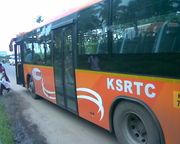
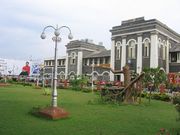
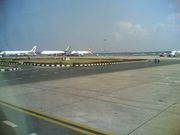
Within the city, city buses, taxis and autorickshaws provide means of transportation. Scooters, motorcycles and regular bicycles are the favoured means of personal transportation.
The intra-city public transport is dominated by the state-owned KSRTC (Kerala State Road Transport Corporation). There are also private bus services, but are limited in number. The city services of KSRTC operate from six depots namely, the City depot, Vikas Bhavan, Peroorkada, Pappanamcode, Kaniyapuram and Vellanad. These services were revamped in 2005 with the introduction of modern buses and electronic ticketing mechanisms. The central city bus terminal is located at East Fort (Kizhakke kotta), near the Padmanabha Swamy temple. The Central and Inter State bus station is located 1 km away at Thampanoor, opposite Thiruvananthapuram Central (Railway) Station. Buses from it go to all major towns and villages in the State as well as big South Indian cities such as Bangalore and Chennai.
The Central railway station is also located at Thampanoor in the heart of the city, 8 km from the airport. It is a very important terminus which handles over 50 trains daily. The city is well connected by rail to almost all major cities in India such as New Delhi, Mumbai, Kolkata, Chennai, Bangalore, Pune, Ahmedabad, Indore, Bhopal, Gwalior, Lucknow, Guwahati, Jaipur etc. Thiruvananthapuram is the first major South Indian city on the second longest train route in the world, Kanyakumari to Jammu. Thiruvananthapuram Pettah and Kochuveli railway station act as satillite stations to Trivandrum Central.[47]
Thiruvananthapuram's International Airport, with direct flights from the Middle East, Singapore, Maldives, Malaysia and Sri Lanka is the gateway to the tourism-rich state of Kerala. There are also two military airports, one near the civilian airport and the other at the Southern Air Command headquarters of the Indian Air Force at Akkulam. Apart from regular scheduled flights, many chartered flights from Europe like First Choice Airways from London Gatwick and Monarch, operating with big jets, land here during the peak tourist season (around December) with Kerala fast becoming a prime tourist destination in India. Thiruvanthapuram airport's importance is also due to the fact that it is the southernmost airport in India and also the closest to (and thus cheapest option for) neighbouring countries like Sri Lanka and Maldives.
The work on infrastructure development for the mega Deep Water Container Trans-shipment Port at Vizhinjam was started. It was expected to be completed within one year and the work on the terminal was to begin within a year.[48] It is to be built in three phases, and expected to be a key competitor in the ports business (especially for container transshipments), with the international shipping lanes between Europe and the Far East very close to the port, and also with major ports like Colombo, Kochi and Tuticorin in close proximity.[49]
The exponential growth of the services and IT-based sectors coupled with its prominence as the state capital and tourist centre has caused considerable strain on the transport infrastructure of the city. To ease the strain, several multi-million dollar construction projects are now underway including the construction of several new underpasses and flyovers. In the first phase, 42 km of six-lane and four-lane dual carriage ways are being built.
Demographics
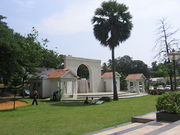
The city has a population of 744,739 according to the 2001 census[50] (nearly 1.1 million in Nov 2006). Within the city, the density of population is about 5,284 people per square kilometer. The district has a literacy rate of 89.36%.[51] With the sex ratio of 1,037 females to every 1,000 males, there are more women in Thiruvananthapuram than men. The wider urban agglomeration registered a population of about one million in 2001.[52]
Hindus comprise 65% of the population, Christians are about 18% of the population, and Muslims are about 15% of the populace. The remaining 2% of the population practice other religions. The major language spoken is Malayalam. English, Tamil, and Hindi are also widely understood. There is also a prominent minority of Tamil speakers and a few Tulu and Konkani speakers.
Unemployment is a serious issue in Thiruvananthapuram, as it is in the whole of Kerala. The increase in the unemployment rate was from 8.8% in 1998 to 34.3% in 2003, thus registering a 25.5% absolute and a 289.7% relative increase in five years.[53] Thiruvananthapuram taluk ranks third in Kerala with 36.3% of its population unemployed. The in-migration of the unemployed from other districts also boosts this high unemployment rate.[53] Thiruvananthapuram has a high suicide rate, which went up from 17.2 per lakh in 1995 to 38.5 per lakh in 2002.[54] In 2004, the rate came down slightly to 36.6 per lakh.[55]
This apparent paradox—high human development and low economic development—is visible in the entire state of Kerala, and is often dubbed as the Kerala phenomenon or the Kerala model of development.[56][57]
Culture
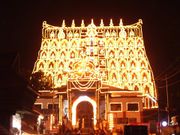
The citizens of Thiruvananthapuram are sometimes referred to as "Trivandrumites" by some tourism sites and blogging community, though the term is not in common use. Thiruvananthapuram has a rich cultural background thanks to the rulers of erstwhile Travancore, who took an active interest in the development of arts and culture. Thiruvananthapuram has produced several great artists, the most famous ones being Maharaja Swathi Thirunal,[59] Irayimman Thampi and Raja Ravi Varma.
Maharaja Swathi Thirunal was a great composer and played a vital role in the development of Carnatic music.[60] There is a music college in his name in the city - Swathi Thirunal College of Music. Raja Ravi Varma was an illustrious painter of international renown. His contributions to Indian art are substantial. Most of his famous paintings are preserved at the Sree Chithra Art Gallery in the city. The Padmanabha Swamy Temple and the fort surrounding it, the Napier Museum and Zoo, the VJT hall, Palayam Mosque and Church are among the prominent heritage buildings in the city. The Veli lake and Shankumugham beach are home to various sculptures of the noted sculptor Kanayi Kunhiraman. Thiruvananthapuram is an unique Indian City, which greenery and modernity co exist. So many great peoples, including Mahatma Gandhi admired the city's greenery.[61]
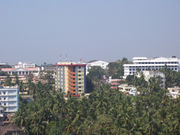
Thiruvananthapuram easily disguises itself as a laid back quiet city to a casual observer. However, beneath it there is a hum of cultural activities. The city comes to life during the festival season of Onam in August/September, and during the tourist season later in the year. The state government organises the tourism week celebrations every year during the Onam with cultural events conducted at various centres in the city. The other major events include the annual flower show, the Attukal Pongala, the Aaraat of Padmanabha Swamy Temple, the Beemapally Uroos, Vettucaud Perunaal etc.[62] The CVN Kalari at East Fort is world renowned centre for training in Kerala's own martial art—the Kalaripayattu. The Margi centre offers training in many of Kerala's traditional arts including Kathakali.
The general cuisine of the people is Keralite cuisine, which is characterised by an abundance of coconut and spices. Other South Indian cuisines, as well as Chinese and North Indian cuisines are popular. Fast food culture is also very prominent in the city.
Thiruvananthapuram has numerous libraries, the prominent ones being the State Central Library (Trivandrum Public library, Est. 1829),[63] the University Library, Thiruvananthapuram Children's Library, Manuscripts Library and the Centre for Development Studies Library. The British Library (Est. 1964)[64] was located very near to the Government Secretariat adjacent to the YMCA Hostel.
Education
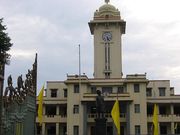
Thiruvananthapuram is a major academic hub. The University of Kerala is located here. There are many professional education colleges including fifteen engineering colleges, three medical colleges, three Ayurveda colleges, two Homeopathy colleges, six other medical related colleges, and two law colleges in the city and its suburbs.[65] Trivandrum Medical College, the premier health institute of the state is also one of the finest in the country. It is being upgraded to the status of an All India Institute of Medical Sciences (AIIMS). The College of Engineering, Trivandrum, Government Engineering College, and Sree Chitra Thirunal College of Engineering are the main engineering colleges in Trivandrum . The Asian School of Business and IIITM-K are two of the management study institutions in the city, both situated inside Technopark. The Indian Institute of Space Science and Technology, the unique and first of its kind in India, is situated here. Centre for Development Studies, one of the foremost development economics research centers in the country, and Centre for Development of Imaging Technology (C-DIT) which does research, development and training in imaging technology are located here.
The schools in the city are classified as Aided, Unaided and Government schools.[66] The government schools are run directly by the state government and follow the syllabus prescribed by the state government. The aided schools also follow the state syllabus. In addition to this, there are four Kendriya Vidyalayas run directly by the Central government, which follow the CBSE syllabus, and private schools run by educational trusts or boards which follow CBSE and/or ICSE syllabus and/or NIOS syllabus and/or state syllabus. The first International school in Kerala, The Trivandrum International School, was started in the outskirts of the city in August 2003.[67] The literacy rate in Thiruvananthapuram, according to the 2001 census, is 89.36 percent; 92.68 percent among males and 86.26 percent among females.[51]
Science and Technology
Thiruvananthapuram is a Research and Development hub in the fields of space science, information technology, bio-technology, medicine and so on. It is home to a cluster of research centres, which include the Indian Institute of Science Education and Research, Vikram Sarabhai Space Centre (VSSC), Liquid Propulsion Systems Centre (LPSC), Thumba Equatorial Rocket Launching Station (TERLS), Indian Institute of Space Science and Technology (IIST), Rajiv Gandhi Centre for Biotechnology, RGCB, Tropical Botanical Garden and Research Institute, ER&DC – CDAC, CSIR – National Institute of Interdisciplinary Science and Technology, Free Software Foundation of India (FSFI), Regional Cancer Centre (RCC), Sree Chitra Thirunal Institute of Medical Sciences and Technology (SCTIMST), Centre for Earth Science Studies (CESS), Central Tuber Crops Research Institute (CTCRI), Priyadarsini Planetarium, The Oriental Research Institute & Manuscripts Library, Kerala Highway Research Institute, Kerala Fisheries Research Institute, etc.
Media
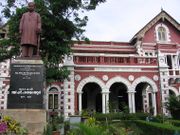
Daily newspapers are available in English and Malayalam. The English newspapers with editions from Thiruvananthapuram are The New Indian Express and The Hindu. The major Malayalam newspapers are Mathrubhumi, Malayala Manorama, Kerala Kaumudi, Deshabhimani, Veekshanam and Madhyamam.
Most Malayalam TV channels are based in Thiruvananthapuram. The government owned Doordarshan began broadcasting from here in 1981. Asianet, the first private Malayalam channel, began its telecasts in 1991. The other channels now based in Thiruvananthapuram are Surya TV, Amrita TV, Kairali TV, Kiran TV (Youth channel of Surya TV) Asianet Plus (Youth channel of Asianet) and People (News and current affairs channel of Kairali TV). The local cable services are provided by Asianet Satellite Communications Limited, Connecttel Communications Pvt Ltd, Trivandrum Cable Network Pvt Ltd and Siti Cable and they provide a bouquet of local channels in addition to all the Indian channels. DTH services are available through Doordarshan Direct Plus, Tata Sky, SUN Direct, Big TV and Dish TV.
All India Radio has an AM (1161 MHz) and an FM (Ananthapuri FM; 101.9 MHz) station for the city. FM radio channels broadcast from Thiruvananthapuram are Ananthapuri FM (AIR) 101.9 MHz, Big FM 92.7 MHz, Club FM 94.3 MHz , Radio Mirchi 98.3 MHz, Red FM 93.5 MHz and Radio DC(Low power CRS) 90.4 MHz.
There are over 18 cinema halls which screen films in Malayalam, Tamil, English and Hindi. There are also two film studios in the city—Chithranjali and Merryland. The Kinfra Film and Video Park, located near the Technopark, is one of the most advanced film and animation production centres in India. Leading firms like Prasad Labs have set up their facilities here. The International Film Festival of Kerala (IFFK) is held in November/December every year and is acknowledged as one of the leading events of its kind in India.
The wireline telephone services are provided by BSNL, Reliance and Tata Indicom. The main GSM networks operating in the city are BSNL CellOne, Airtel, Aircel, Tata Docomo, Uninor, Idea Cellular, Vodafone, Reliance, Videocon and Virgin Mobile. The main CDMA providers are Reliance, MTS and Tata Indicom. The number of mobile phone connections has increased exponentially since the late 90s. Major broadband internet services are provided by BSNL DataOne, Asianet Dataline and Siti Cable. Private providers like Reliance, Tata Communications (VSNL), Airtel and Satyam also have their presence in the city. The major dial-up internet providers are BSNL NetOne, Kerala Online and KelNet among others. Thiruvananthapuram also holds the distinction of having been the first 100% Digital SSA (Secondary Switching Area) in India.
Sports
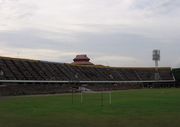
The most popular games are Football and Cricket.[68] Basketball, Badminton and Volleyball are also popular, mostly in schools. The Kerala Cricket Association (KCA) is headquartered in Thiruvananthapuram. The HQ complex of KCA, has advance facilities including two practice turfs with nets, bowling machines, gymnasium with multi-gym and equipment for aerobic training, lecture hall and library, an astro-turf indoor coaching facility, fully furnished accommodation for coaches and players, a physiotherapy clinic, functional office facilities and guest rooms. The Chandrasekharan Nair Stadium, in the heart of the city, is a prominent football stadium and has hosted both national and international level matches. The University Stadium has hosted two international cricket matches. This stadium is under the University of Kerala and is equipped with synthetic tracks for athletics games. The Central Stadium, which has facilities for athletics, football, basketball, volleyball and cricket practice nets, is situated on the eastern side of the Government Secretariat. The Jimmy George Sports Complex, the GV Raja Sports School and Lakshmi Bhai National College for Physical Education (LNCPE) are the other major sports establishments in the city. The city also has a Golf Club, one of the oldest in India, and a Tennis Club (Trivandrum Tennis Club/TTC) both located at Kowdiar. The city fields two football clubs--SBT-Thiruvananthapuram and Titanium—in the second division of the National Football League. The city also has a fully equipped modern swimming pool located near the Jimmy George Sports Complex at Vellayambalam. Many state level and national level swimming competitions are held in this complex. It also holds coaching camps for those who are interested in learning swimming.
Strategic Importance
Apart from being the capital of India’s most literate[69] and socially developed state,[70][71] Thiruvananthapuram is a strategically important city in Southern India. Being the largest city in India’s deep south, it is important for both military logistics and civil aviation in the southern part of the country. It is the headquarters of the Southern Air Command (SAC) of the Indian Air Force.[72] The city is very close to the international shipping route and East-West shipping axis.[41] Also, it falls under the international air route.[73] Due to the strategic importance of the city, the Indian Air Force authorities have planned to establish an aerospace command in SAC.[74] The plan for setting up a new "Tri-Service Command", which will integrate all the three forces under a single command, is also in the pipeline.[75]
Being the Indian city with the closest air link to the small island-country of Maldives and also Sri Lanka,[76] the city’s medical and health infrastructure caters to the needs of the patients from both countries, especially Maldives.[77] Exports of perishables and medicines from Trivandrum International Airport run to full capacity on the daily flights to Maldives and Sri Lanka. Thiruvananthapuram also provides a key link in the movement of goods and passengers to and from southern parts of Tamilnadu into Kerala, the state border being just 30 km away from the city centre. The city is also important for people around the world seeking help through Ayurveda medicine and therapy. Ayurveda resorts are coming up at a rapid pace along the International Beach of Kovalam and Varkala coast.
Sister Town / Twin Cities
Thiruvananthapuram is twinned with the following cities:[78][79][80]
| City | Country | State / Region | Since |
|---|---|---|---|
| 1994 | |||
| 2009 |
Gallery
 Secretariat building, Government of Kerala |
 Kaudiar road; also known as the royal road, as it leads to the Palace |
 Trivandrum Public library |
 Napier Museum |
|
A sculpture at Shankumugham Beach by Kanayi Kunhiraman. |
Jalakanyaka at Shankumugham Beach by Kanayi Kunhiraman |
Thiruvananthapuram Model School, one of the oldest schools in the city |
Notes
- ↑ "India: largest cities and towns and statistics of their population". World Gazetteer. http://world-gazetteer.com/wg.php?x=&men=gcis&lng=en&des=wg&geo=-104&srt=1npn&col=abcdefghinoq&msz=1500. Retrieved 2010-03-10.
- ↑ "India: metropolitan areas". World Gazeteer. http://www.world-gazetteer.com/wg.php?x=&men=gcis&lng=en&dat=80&geo=-104&srt=pnan&col=aohdq&msz=1500&va=&pt=a. Retrieved 2010-03-10.
- ↑ "Trivandrum India". Destination 360. http://www.destination360.com/asia/india/trivandrum. Retrieved 2010-06-18.
- ↑ "India: metropolitan areas". World Gazetteer. http://www.world-gazetteer.com/wg.php?x=&men=gcis&lng=en&dat=80&geo=-104&srt=pnan&col=aohdq&msz=1500&va=&pt=a. Retrieved 2010-03-10.
- ↑ "Trivandrum India". Destination 360. http://www.destination360.com/asia/india/trivandrum. Retrieved 2010-06-18.
- ↑ "Kerala: State poised for IT leap". IT infrastructure developed by the government had increased by 81 per cent.. The Hindu. http://www.hindu.com/2010/05/24/stories/2010052457850400.htm. Retrieved 2010-06-18.
- ↑ "Kerala: Tourism on a growth trajectory". Tourism on a growth trajectory. The Hindu. http://www.hindu.com/2008/04/15/stories/2008041553690400.htm. Retrieved 2010-06-18.
- ↑ "Thiruvananthapuram". About Thiruvananthapuram. Department of tourism, Government of Kerala. http://www.keralatourism.org/thiruvananthapuram.php. Retrieved 2010-06-18.
- ↑ "Thiruvananthapuram - Kerala - India". The city gets its name from the word, Thiru-anantha-puram.. http://thiruvananthapuram.net/. Retrieved 2010-06-18.
- ↑ "Kowdiar palace". About Kowdiar palace. Zonkerala. http://www.zonkerala.com/tourism/Kowdiar-Palace-9.html. Retrieved 25 June 2010.
- ↑ De Beth Hillel, David (1832). Travels (Madras publication).
- ↑ Lord, James Henry (1977). The Jews in India and the Far East; Greenwood Press Reprint; ISBN 0-8371-2615-0.
- ↑ "Ancient Trade in Thiruvananthapuram". Facts You Never Knew about India. University of Stanford. http://www.stanford.edu/~ctj/keralfor.html. Retrieved 2006-10-17.
- ↑ "Ancient Trade in Trivandrum". About Trivandrum. Technopark Kerala. http://www.technopark.org/abttvm01.htm. Retrieved 2006-10-17.
- ↑ 15.0 15.1 "History of Thiruvananthapuram". Kerala PRD. http://www.kerala.gov.in/knowkerala/tvm.htm. Retrieved 2006-05-23.
- ↑ "District Profile". About Thiruvananthapuram. National Informatics Centre District Centre, and Content Management Team Collectorate Thiruvananthapuram. http://trivandrum.gov.in/trivandrum/index.php/district-profile-mainmenu-73. Retrieved 2010-05-22.
- ↑ "VSSC Trivandrum". Indian Space Research Organisation. http://www.isro.org/centers/cen_vssc.htm. Retrieved 2006-05-23.
- ↑ "First IT Park in Kerala". Kerala State IT Mission. http://www.keralaitmission.org. Retrieved 2006-08-25.
- ↑ "IT Companies in Kerala". Kerala State IT Mission. http://www.keralaitmission.org. Retrieved 2006-08-25.
- ↑ 20.0 20.1 "Thiruvananthapuram offers best IT infrastructure: Survey". ciol. http://www.ciol.com/content/news/2006/106072505.asp. Retrieved 2006-08-25.
- ↑ "Thiruvananthapuram, India Page". Falling Rain Genomics, Inc. http://www.fallingrain.com/world/IN/13/Thiruvananthapuram.html. Retrieved 2008-03-19.
- ↑ "Rainfall Stations in India". Indian Institute of Tropical Meteorology (Pune). http://envis.tropmet.res.in/rainfall_stations.htm. Retrieved 2010-06-18.
- ↑ Geological Survey of India. Seismic zoning map of India [map]. Retrieved 2010-07-01.
- ↑ The Indian encyclopaedia: biographical, historical, religious ..., Volume 2 2010, p. [1]
- ↑ "Trivandrum Climate". Weatherbase. http://www.weatherbase.com/weather/weather.php3?s=017334&refer=. Retrieved 2006-08-25.
- ↑ "Trivandrum Seasons". Weatherbase. http://www.weatherbase.com/weather/weather.php3?s=017334&refer=. Retrieved 2010-06-18.
- ↑ "Thiruvananthapuram". http://www.imd.gov.in/section/climate/thiruvananthapuram1.htm. Retrieved 2010-03-21.
- ↑ "Trivandrum, India". Whetherbase. http://www.weatherbase.com/weather/weather.php3?s=17334&refer=&units=metric. Retrieved July 1, 2010.
- ↑ "80 percent growth in software exports in four years". Manoramaonline. 2010. http://www.manoramaonline.com/cgi-bin/MMOnline.dll/portal/ep/itcontentView.do?contentId=7278515&programId=6037348&contentType=EDITORIAL&BV_ID=@@@. Retrieved 27 June 2010.
- ↑ "KINFRA Film and Video Park, now a complete digital infotainment ecosystem". The KINFRA Film and Video Park covers the gamut of infotainment activities. India Tech. http://www.indiatechonline.com/kinfra-film-and-video-park-181.php. Retrieved 27 June 2010.
- ↑ "Kinfra Film & Video Park to house animation zone". The Hindu Bussness Line. Friday, Dec 26, 2003. http://www.thehindubusinessline.com/2003/12/26/stories/2003122600441100.htm. Retrieved 27 June 2010.
- ↑ "First IT Park in Kerala". Kerala State IT Mission. http://www.keralaitmission.org. Retrieved 2006-08-25.
- ↑ "IT companies in Technopark". Kerala State IT Mission. http://www.keralaitmission.org/web/sec4/?action=0&what=100014. Retrieved 2006-05-24.
- ↑ "Technopark - Harmont at work". IT parks In Kerala. Department of IT, Govt. of Kerala. http://www.keralait.org/search_result.php?project_id=2&location_id=5&start=1. Retrieved 2010-06-28.
- ↑ "Technopark - Harmont at work". Phase IV - Technocity. Technopark. http://www.technopark.org/phase4.htm. Retrieved 2010-06-28.
- ↑ "Trivandrum tops in the number of International tourists." (PDF). Statistics of Tourists in 2007.. Tourism Dept, Kerala. http://www.keralatourism.org/tourismstatistics/Microsoft%20Word%20-%20Tourist_statistics_for_Internet.pdf. Retrieved 2008-05-08.
- ↑ "Trivandrum tops in the number of International tourists." (PDF). Statistics of Tourists in 2005.. Tourism Dept, Kerala. http://www.keralatourism.org/php/media/data/tourismstatistics/TOURISTSTATISTICS2005.pdf. Retrieved 2006-10-02.
- ↑ "Kerala: Earnings cross Rs.10,000 crore from Tourism.". Tourism on a growth trajectory. The Hindu. http://www.hindu.com/2008/04/15/stories/2008041553690400.htm. Retrieved 2008-05-08.
- ↑ "Statistical data". Kerala Government. http://www.kerala.gov.in/statistical/panchayat_statistics2001/thiru_cont.htm. Retrieved 2006-08-25.
- ↑ "Vizhinjam terminal will reduce movement cost - Boost the economy". The Hindu Business Line. 2005-08-29. http://www.thehindubusinessline.com/2005/08/30/stories/2005083000410700.htm. Retrieved 2006-09-18.
- ↑ 41.0 41.1 "Features of Vizhinjam Port" (PDF). Kerala Government. http://kerala.gov.in/transshipment/salient.pdf. Retrieved 2006-09-22.
- ↑ "Assembly Constituencies - Corresponding Districts and Parliamentary Constituencies" (PDF). Kerala. Election Commission of India. http://archive.eci.gov.in/se2001/background/S11/KL_Dist_PC_AC.pdf. Retrieved 2008-10-21.
- ↑ "City Police of Thiruvananthapuram". General Information.. Thiruvananthapuram City Police. http://www.tvmcitypolice.org/generalinformation.jsp. Retrieved 2006-08-25.
- ↑ "Consulate / Embassy in Thiruvananthapuram". Embassies and Consulates in India .. High Commission of the Republic of Maldives. http://www.maldiveshighcom.co.in/maldives/Tiruvananthapuram/AboutCosulate.htm. Retrieved 2006-08-25.
- ↑ 45.0 45.1 "Electricity and Water supply in Thiruvananthapuram". Infrastructure. Government of Kerala. http://kerala.gov.in//tvmnew/infrastracture.htm. Retrieved 2006-10-02.
- ↑ "Thiruvananthapuram Sewerage Scheme". Sewage Treatment in Thiruvananthapuram. Government of Kerala. http://keralawater.org/sewer.htm. Retrieved 2006-10-16.
- ↑ "Railway stations in Thiruvananthapuram". Google Maps. Google. http://www.google.co.in/#hl=en&safe=off&q=Railway+Stations+in+Thiruvananthapuram&aq=f&aqi=&aql=&oq=Railway+Stations+in+Thiruvananthapuram&gs_rfai=&fp=875d5b091348a2d4. Retrieved 22 August 2010.
- ↑ "Work on Vizhinjam infrastructure on". The Hindu. Aug 17, 2010. http://www.hindu.com/2010/08/17/stories/2010081763260400.htm. Retrieved 22 August 2010.
- ↑ "Vizhinjam - Data Sheet". Dept of ports, Kerala Government. http://www.keralaports.gov.in/vizhinjm.htm. Retrieved 2006-09-22.
- ↑ "Population of Trivandrum City". Kerala city populations. City Population. http://www.citypopulation.de/India-Kerala.html. Retrieved 2006-05-23.
- ↑ 51.0 51.1 "Literacy rate in Thiruvananthapuram". Education status in Kerala. Kerala Government. http://www.kerala.gov.in/education/status.htm. Retrieved 2006-09-26.
- ↑ "Population of Trivandrum UA". City Population. http://www.citypopulation.de/World.html. Retrieved 2006-05-23.
- ↑ 53.0 53.1 K. C. Zachariah and S. Irudaya Rajan (2005) (PDF Format). Unemployment in Thiruvananthapuram. K. C. Zachariah and S. Irudaya Rajan. http://www.sacw.net/Labour/uneployementkerala.pdf. Retrieved 2006-10-02.
- ↑ "Kerala - Suicide rates". Suicide. Kerala State Mental Health Authority. http://www.ksmha.org/suicide.htm. Retrieved 2006-10-02.
- ↑ "Suicide rate going up in district". The Hindu. 2006-03-13. http://www.hindu.com/2006/03/13/stories/2006031320990300.htm. Retrieved 2006-10-02.
- ↑ Tharamangalam 2005, p. 1.
- ↑ Brenkert & Malone 2003, p. 48
- ↑ "Padmanabha Swamy Temple at Thiruvananthapuram, Capital of Kerala State, India". About Padmanabhaswamy Temple. angelfire. http://www.angelfire.com/musicals/kallidaihari/padmana_reflect.html. Retrieved 25 June 2010.
- ↑ "Life of HH Swathi Thirunal". Swathi Thirunal's life. C-Dit. http://www.swathithirunal.in/. Retrieved 2006-08-25.
- ↑ "Swathi Thirunal; Musician and ruler.". Swathi Thirunal's reign. Kerala Government. http://www.kerala.gov.in/music/music4.pdf#search=%22swathi%20thirunal%22. Retrieved 2006-08-25.
- ↑ 61.0 61.1 "Queen of Bhutan savours State's lush green landscape". The Hindu. 2006-02-17. http://www.hindu.com/2006/02/17/stories/2006021714590400.htm. Retrieved 2010-06-18.
- ↑ "Festivals". A look in to the Festivals in Thiruvananthapuram .. Kerala Government. http://www.tvm.kerala.gov.in/festivals.htm. Retrieved 2006-08-25.
- ↑ "Trivandrum Public Library". State Central Library .. Government of Kerala. http://www.kerala.gov.in/public_library/index.htm. Retrieved 2006-08-25.
- ↑ "British Library in Thiruvananthapuram city". Libraries in India under the British council. Kerala State IT Mission. http://www.britishcouncil.org/india-regional-thiruvananthapuram.htm. Retrieved 2006-08-25.
- ↑ "Technical Education in Kerala - Department of Technical education". Professional Colleges in Thiruvananthapuram. Kerala Government. http://www.kerala.gov.in. Retrieved 2006-08-25.
- ↑ "Education in Thiruvananthapuram". Schools in Thiruvananthapuram. Kerala Government. http://www.tvm.kerala.gov.in/education.htm. Retrieved 2006-08-25.
- ↑ "Trivandrum International School opens doors". The Hindu Business Line. 2003-10-08. http://www.thehindubusinessline.com/2003/08/04/stories/2003080400591300.htm. Retrieved 2006-10-08.
- ↑ "Football and Cricket - the Most Popular Games". Games in Kerala. Informations and Public relations office of Kerala. http://www.prd.kerala.gov.in/sportsmain.htm. Retrieved 2006-06-12.
- ↑ "Literacy rate in Indian states and Union Territories". Number of Literates & Literacy Rates (Excluding J & K).. Census Department. http://www.censusindia.gov.in/. Retrieved 2006-09-16.
- ↑ "Kerala: Human Development Fact Sheet" (PDF). "Kerala: Human Development Fact Sheet". United Nations Development Programme (UNDP). http://www.undp.org.in/programme/undpini/factsheet/kerala.pdf. Retrieved 2006-09-16.
- ↑ "Kerala Model" (PDF). "EFA (Education for All) Global Monitoring Report",(2003). UNESCO. http://www.unesco.org/education/efa_report/chapter4.pdf. Retrieved 2006-09-16.
- ↑ "Southern Air Command, Akkulam, Thiruvananthapuram". Air Commands in India .. Indian Air Force. http://indianairforce.nic.in/show_page.php?pg_id=32&page_type=command&comm_id=5. Retrieved 2006-08-29.
- ↑ "Refuelling destination". The Hindu. 2006-08-04. http://www.hindu.com/2006/08/04/stories/2006080423940300.htm. Retrieved 2006-10-09.
- ↑ "SAC to be made aerospace command soon". The Hindu. 2005-10-09. http://www.hindu.com/2005/10/09/stories/2005100910170400.htm. Retrieved 2006-08-25.
- ↑ "Tri-service command likely at Thiruvananthapuram". WebIndia. 2006-08-30. http://news.webindia123.com/news/Articles/India/20060830/436340.html. Retrieved 2006-09-15.
- ↑ "Connectivity". Maps of India.. Maps of India. http://www.mapsofindia.com/maps/kerala/thiruvananthapuram.htm. Retrieved 2006-10-09.
- ↑ "Maldivian embassy - Independence day celebration". Embassy news (High Commission of the Republic of Maldives). 2006-07-26. http://www.maldiveshighcom.co.in/maldives/news/jul2006/jul2006%5B14%5D.htm. Retrieved 2006-08-25.
- ↑ "Barcelona team arrives". The Hindu. 2009-01-10. http://www.hindu.com/2009/10/01/stories/2009100158750300.htm. Retrieved 2009-10-13.
- ↑ "Kerala capital to get a cousin in Europe". arabnews. 2009-01-10. http://www.arabnews.com/?page=4§ion=0&article=125013&d=31&m=7&y=2009. Retrieved 2009-07-31.
- ↑ "Galveston-Trivandrum sister city society". © www.gtscsociety.com. http://www.webdigi.com/gtscsociety/home.asp. Retrieved 2009-10-13.
References
- Manorama Yearbook 1995 (Malayalam Edition) ISSN 0970-9096
- Manorama Yearbook 2003 (English Edition) ISBN 81-900461-8-7
- Frank Modern Certificate Geography II ISBN 81-7170-007-1
- Growing Populations, Changing Landscapes - Studies from India, China and United States 2001 (National Academy Press, Washington DC)
External links
- Official District website
- Public Relations Department Page on Trivandrum
- Government of Kerala Website on Thiruvananthapuram District
- List of Educational Institutions under University of Kerala
|
||||||||||||||||||||||||||||||||||||||||
|
||||||||
|
||||||||||||||||||||||||||||||||||||||||
|
|||||||||||||||||||||||||||||
